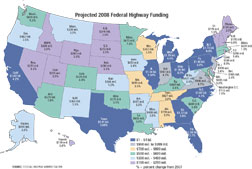Record Transportation Funding Spurs Spike in Bridge Projects
 Trinity River Corridor Project The Margaret Hunt Hill Bridge, designed by Santiago Calatrava, features a 395-ft-tall parabolic steel arch.
|
As transportation funding reaches record levels nationwide, state and local authorities are making bridge work a fiscal priority in their budgets, focusing on reducing the number of structurally deficient and functionally obsolete bridges in their inventories. In the wake of the Interstate 35-W bridge collapse in Minneapolis in August, the spotlight is shining even brighter on the need for infrastructure improvements on the nation's highways, sparking a reaction among legislators that could funnel more funding into the sector.
According to estimates from the American Road & Transportation Builders Association, Washington, D.C., the value of bridge and highway construction put in place will hit $75.2 billion in 2007, a 4.5% increase over 2006. Although values continue to climb, this year the market has seen a cooling down compared to the 12.1% increases seen in 2006 and the 9.4% increase in 2005.
Bridge projects are rising faster. In 2005, bridge work put in place rose 7.3% to $14.8 billion, then jumped 37.3% in 2006 to $20.4 billion. The sector is expected to wrap up 2007 with a 16% increase to $23.6 billion. By comparison, highway pavement work has ranged between $44 billion and $45 billion for the last three years.
ARTBA Vice President and Chief Economist Bill Buechner says the recent increases in bridge work are part of a long-term trend among state and local authorities to focus on the sector. A decade ago, about 20% of all money spent by state and local authorities went to bridge improvements, he says. Now, it is closer to 30%. “The state DOTs have been putting a lot of money into addressing the bridge problem,” Buechner says.
| + click to enlarge |
 |
| The fiscal 2008 transportation spending bill boosts highway spending to record levels and includes $1 billion for deficient bridges.
|
Statistics suggest that the move is having an impact. According to the U.S. Dept. of Transportation, the number of structurally deficient or functionally obsolete bridges nationwide dropped from 167,581 in 2000 to 152,428 in 2007. However, federal funds so far have played a limited role in supporting that trend. Buechner notes that the federal bridge program has seen its share of federal highway bill funding drop in the past decade, currently accounting for nearly 11% of funding in SAFETEALU. “This certainly has not been a mandate from the Federal Highway Administration,” Buechner says. “It has all been decisions taking place at the state and local level.”
Changing Views
But that could change. Outrage over the collapse of the Interstate 35-W bridge in August prompted the Senate to call for an additional $1 billion in federal funds for bridge improvements in fiscal year 2008 an increase of nearly 20%. With the increase, the FHWA’s Bridge Replacement and Rehabilitation Program would hit $6.3 billion for the year. Under the proposed funding hike, California and New York would each receive an additional $100 million. Pennsylvania would get $94 million more and Louisiana $40 million.In October, the House Transportation Committee approved legislation that would offer $2 billion for bridge improvements nationwide. Committee Chairman Jim Oberstar (Minn.) originally had proposed a three year $25-billion package, but the measure, which called for a 5¢-per-gallon fuel tax increase, was shot down in committee.
Although work on the bridge funding bills continues and would need to be approved by President Bush, Dave Bauer, vice president of government affairs at ARTBA, says the recent activity in Congress sends a strong message. “You won’t see any sort of short-term attention span brought to this problem,” Bauer says. “The immediate action to increase bridge funding in fiscal year 2008 is a strong message in the short term, but the fact that Chairman Oberstar is looking into it suggests that there will be a sustained effort at the federal level on addressing bridge conditions.”
Among the immediate needs for federal funds is the I-35W bridge replacement. In September, lawmakers authorized $250 million to clean up the site and build a replacement bridge, but funds have not yet been fully appropriated. In October, Minnesota DOT awarded a $243-million...

